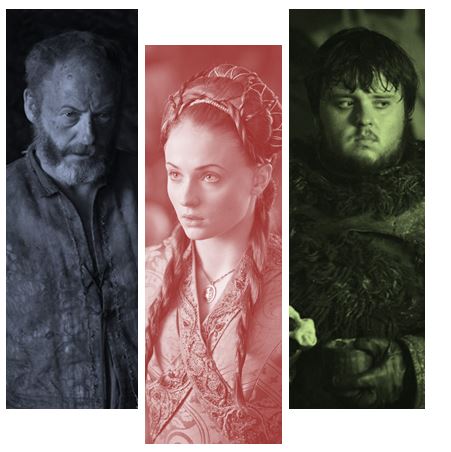******!!!!!SPOILERS!!!!!*****
Happy Season Four of Game of Thrones! One of my wild predictions already came true—Oberyn did get some sexy time, including with a dude. Oberyn is a darn fine piece of ass! But my post is going to be not about him or even GoT, but about nerdy book-related stuff.
While reading A Song of Ice and Fire, I noticed that the POVs were not created equal. Of course, they all differ in importance—we and GRRM care more about Tyrion than we do about all those “Oreo” dudes from the fourth book—but there’s more to it. In the case of each POV, GRRM emphasizes a different function in relation to the story. According to that emphasis, I’ve grouped the POVs into three categories.
“Cornerstone” or “Character Development” POVs
In the chapters dedicated to those guys, GRRM places an emphasis on their personal journeys. These are the characters that are out-of-the-ordinary in some way, and they undergo drastic changes as the story progresses. We closely follow their mental states and their changing relationship to the world around them. It is expected that they will play very important roles in the books to come—it is them who feature heavily in fan theories about prophecies (“Azor Ahai,” “the three heads of the dragon.”) They probably will not die, and if they do, it will be at the very end. Of all of the POVs, they are the closest to the definition of “heroes,” in that ASoIaF is as much a story about Westeros as it is a compendium of their stories.
“Cornerstone” characters include Tyrion, Dany, Jon Snow, Arya, Jaime, Bran, Theon, Cersei (the journey deep into villainy), and possibly Victarion.
Plot-Driving POVs
These boys and girls exist primarily as devices to propel the whole story forward (as opposed to driving forward their own stories, which is the case for “cornerstones”). To see what I mean as a “device,” let’s take the case of Khal Drogo, even though he is not a POV. I like looking at Jason Momoa as much as the next straight female, but let us face the fact that he had no reason to exist beyond what he had already done to Dany. His only purpose in the story was to serve as a catalyst for her transformation from a doormat to a fiery queen. Same goes for POVs Eddard and Catelyn, but instead of helping transform other characters, they change the history of Westeros. We do not learn all of the details about the mental evolution of Ned (compare that to Jaime or Arya), because in the end, his only purpose was to have his head chopped off.
I also included in this category the “smaller” POVs such as Areo, Arys, and Arianne (all those “Oreos”), because their main function is to perform actions that lead to important consequences or revelations. For example, it is because of Arianne’s rebellion against her dad we learn the crucial bit about the Martell-Targaryen agreement.
Brienne might also be considered a “plot-driver” because she aids in the transformation of Jaime. All of her roads so far have led to him. She also acts as a device through which we can see Westeros as a war-ravaged place. A lot of people hate her chapters in A Feast for Crows, but I feel that they are truly necessary to establish a post-apocalyptic atmosphere. Her function there is “witnessing.” Quentyn can also be construed as a witness, because his adventures permit us to learn more about Essos and all its crazy armies.
Other plot-driving characters include Aeron, Melisandre, and Barristan Selmy.
“Everyman” POVs
This one is a bit tricky. These POVs are similar to the “cornerstones” in that GRRM is attentive to their personal evolution, and they surely do drive the plot. What sets them apart is their “normalcy,” their relative lack of extraordinary traits. They are the easiest to identify with. Consider Davos, who is a textbook “normal decent guy.” Or Sam, who might be GRRM himself. Or Sansa, who lets us see crazy events from the perspective of a regular teenage chick. They do not oscillate madly between halfway decent and evil, like Jaime and Theon, and they do not verge on the edge of the superhuman, like Bran, Arya, Dany, and Jon Snow. But we also follow them as they change and grow—this is especially true about Sansa and Sam.
Next week, I will talk about awesome Game of Thrones t-shirts and where to buy them!



This is a great analysis of the characters, which doesn’t restrict them. Sansa is an everyman character, but theoretically could move to a different role in the POV hierarchy.
Very thought provoking.
heheh! thnx!
I’m very happy about the hint of flirtation between Oberyn and Loras, especially knowing that Ellaria Sand full approves. I love it! So hot!
Yea, this is one of the reasons why GoT is so wonderful–uninhibited lust.